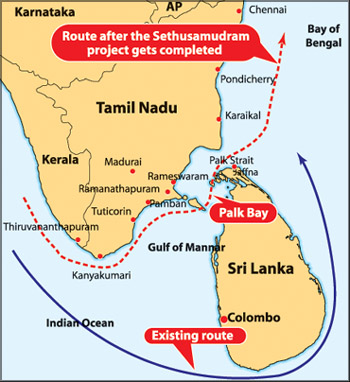A ‘bridge’ that divides
Laurie Goering
To engineers hoping to dredge a shipping canal, the chain of tiny
submerged islands stretching across the straits separating India and Sri
Lanka are part of an old natural ridge of ocean sand and coral.
But to India’s Hindu nationalists, they are something sacred:
remnants of the stone bridge built by an army of monkeys to help Ram, a
Hindu hero, cross to Sri Lanka to rescue his kidnapped wife from a demon
king.
In India, a land rich in history and religious epics, sacred ground
is everywhere, and building just about anything involves dodging
ubiquitous shrines, tombs and monuments.
But a plan to slice through Ram’s Bridge, as the ridge is known, has
created an epic furore, with the government accused of blasphemy, an ailing Hindu nationalist political
party angling for a comeback and Hindu religious leaders trying to
retract a demand for a state politician’s head.
government accused of blasphemy, an ailing Hindu nationalist political
party angling for a comeback and Hindu religious leaders trying to
retract a demand for a state politician’s head.
“It’s the rationalists versus the believers,” said George Verghese, a
longtime New Delhi journalist and author on Indian development issues.
“But it’s also rather crude politics on all sides.”
For most of a century, India’s government has pondered dredging a
deep shipping canal through the shallow straits that separate India and
Sri Lanka as a way of connecting the Bay of Bengal and the Arabian Sea
and shortening transit times for ships, which must circle south of Sri
Lanka to make the trip.
But when the Government recently settled on a route for the canal
that cut through Ram’s Bridge - other routes threatened shrines or
worsened ecological damage - Hindu petitioners filed a court objection,
citing Nasa photos of the submerged “bridge” and appropriate text from
the Ramayana, an ancient epic of Lord Ram’s exploits.
According to the story, Ram enlisted the help of Hanuman, his monkey
aide, and his monkey army to throw stones into the straits separating
India and Sri Lanka to build a floating bridge. Ram’s army then used the
bridge to rescue Sita, his kidnapped wife.
Called in to reply to the complaint, the Archaeological Survey of
India filed a statement that the Ramayana could not be considered a
historical record to “incontrovertibly prove the existence of the
characters or the events depicted therein,” a statement received by
hard-line Hindu opposition politicians in the same way conservative
Baptists in the US might take a Government suggestion that Jesus could
be mythological.
In the resulting furore, the Hindu chief minister of Tamil Nadu
state, home to the disputed bridge and a southern Indian population that
disputes Ram’s hero status, demanded: “Who is this Rama? From what
engineering college did he graduate? Is there any proof for this?”
The leader of the World Hindu Council then insisted that anyone who
beheaded the chief minister would be “weighed in gold by the saints,” a
statement he later revoked while still insisting that the tongues of
blasphemers should be cut out. A host of popular gurus, meanwhile,
questioned whether India’s Government had “disowned” its heritage.
With the opposition Hindu Bharatiya Janata Party rushing to fan the
flames to try to collect votes, the Government quickly backed down,
withdrawing the controversial report and asking for a three-month
adjournment of the Supreme Court case.
But the saga, which resulted in two deaths in nationwide protests,
has raised questions over where the fine line between fact and faith
should be set. It’s a particularly difficult question in a country with
a huge demand for new infrastructure projects, a long history and a rich
pantheon of gods who play a part - culturally if not religiously - in
the day-to-day lives of most people.
“In a country as rich in cultural and historical diversity as India,
which has an established history ranging over nearly 9,000 years, the
line between myth and reality is often obliterated,” acknowledged the
Archaeological Survey of India.
The Ram’s Bridge controversy, Indian academics say, is not unlike the
dispute in the United States over whether the scientifically supported
theory of evolution or the biblical tale of creationism should be taught
in schools.
Chicago Tribune |

